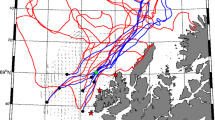Summary
A radar system is presented which allows the measurement of surface currents in a coastal area of about 50 km×50 km. The basic theoretical ideas of this system are described as well as the measuring equipment and date processing developed by Barrick, Evans and Weber [1977] from NOAA (National Oceanic and Atmospheric Administration).
Radar data are available from the German Bight for a 26-hour period during MARSEN 1979 (Marine Remote Sensing Experiment in the North Sea). The data have been evaluated in terms of surface currents and compared with a record from a moored current meter, 7 metres below the surface. According to the comparison surface currents as observed by radar differ from the conventionally measured subsurface currents not more than 15 cm s−1 in speed. With regard to the current direction the agreement between both independent measurements seems to be best (within 10 degrees) when the surface-current speed exceeds 30 cm s−1.
However, these comparative numbers do not take into account near-surface vertical shears. Thus, currents measured by means of radar are probably more accurate than those numbers indicate.
Zusammenfassung
Es wird über ein Radarsystem berichtet, das die Messung der Oberflächenströmung in einem küstennahen Gebiet von ca. 50 km×50 km gestattet. Die zugrundeliegende Theorie sowie die von Barrick, Evans und Weber [1977] bei der NOAA entwickelten Geräte einschließlich der Datenverarbeitung werden beschrieben.
Für einen 26stündigen Zeitraum während MARSEN (Marine Remote Sensing Experiment in the North Sea) sind aus der Deutschen Bucht vom Oktober 1979 Radardaten ausgewertet worden. Diese Daten liefern Oberflächenströmungen, die mit den Meßergebnissen eines verankerten Strommessers in 7 m Tiefe verglichen werden. Bezüglich der Geschwindigkeit ergeben sich Unterschiede bis zu 15 cm s−1 zwischen den Strömungsmessungen mit dem Radar und dem Strommesser. Die Strömungsrichtungen aufgrund beider unabhängigen Messungen stimmen am besten überein (innerhalb 10°), wenn die Oberflächenstromgeschwindigkeit größer als 30 cm s−1 ist.
Der Vergleich zwischen den Radar- und Strommesserdaten berücksichtigt vertikale Strömungsscherungen in Oberflächennähe nicht, so daß die Radarmessungen wahrscheinlich genauer sind als das Vergleichsergebnis andeutet.
Résumé
On présente un système radar qui permet de mesurer les courants de surface dans une zone côtière d'environ 50 km×50 km. On décrit les principes fondamentaux du système ainsi que l'équipement de mesure et le traitement des données développé par Barrick, Evans et Weber [1977] du NOAA. Des données radar ont été obtenues dans la Baie Allemande pendant une période de 26 heures lors de l'expérience MARSEN 1979 (Marine Remote Sensing Experiment in the North Sea).
Les données ont permis d'évaluer les courants de surface et elles ont été comparées aux enregistrements d'un courantomètre mouillé à 7 mètres sous la surface. Il ressort de la comparaison que les courants de surface observés au radar ne diffèrent pas de plus de 15 cm s−1 des courants de subsurface mesurés de façon classique. Si l'on considère la direction du courant, l'accord entre les deux méthodes indépendantes est le meilleur (écart inférieur à 10°) quand la vitesse du courant de surface dépasse 30 cm s−1. Toutefois, ces données comparatives ne font pas entrer en compte les mouvements de cisaillement dans la verticale à proximité de la surface. Partant, les courants mesurés au moyen de radar sont probablement plus précis qu'il n'est indiqué par ces chiffres.
Similar content being viewed by others
References
Barrick, D. E., 1971: Theory of HF and VHF propagation across the rough sea. Radio Sci.6, 517–533.
Barrick, D. E., M. W. Evans and B. L. Weber 1977: Ocean surface currents mapped by radar. Science.198, 138–144.
Crombie, D. D., 1955: Doppler spectrum of sea echo at 13.56 Mc/s. Nature.175, 681–682.
Deutsches Hydrographisches Institut, 1980: Beobachtungen auf den deutschen Feuerschiffen der Nord- und Ostsee im Jahre 1979 sowie Monatsmittelwerte von Temperatur und Salzgehalt des Jahres 1979. Meereskund. Beob. Ergebn. Nr. 50, 134 pp.
Frisch, A. S., and B. L. Weber, 1980: A new technique of measuring tidal currents by using a two-site HF Doppler radar system. J. Geophys. Res.85, 485–493.
Halpern, D., and D. Pillsbury, 1976: Nearsurface moored current meter measurements. Mar. Techn. Soc. J.10, No 7, pp. 32–38.
Hasselmann, K., 1966: Feynman diagrams and interaction rules of wave-wave scattering processes. Rev. Geophys.4, 1–32.
Stewart, R. H., and J. W. Joy, 1974: HF radio measurements of surface currents. Deep-Sea Res.21, 1039–1049.
Author information
Authors and Affiliations
Rights and permissions
About this article
Cite this article
Essen, HH., Mittelstaedt, E. & Schirmer, F. On near-shore surface current measurements by means of radar. Deutsche Hydrographische Zeitschrift 34, 1–14 (1981). https://doi.org/10.1007/BF02227001
Received:
Issue Date:
DOI: https://doi.org/10.1007/BF02227001




